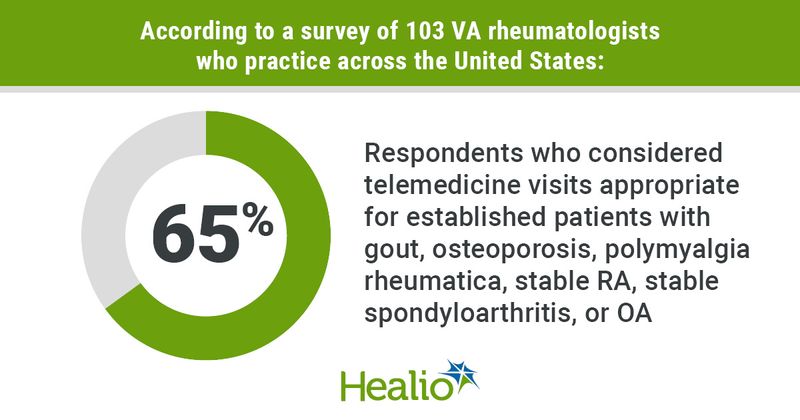Most VA rheumatologists consider telemedicine apt for regular patients with gout, RA, OA
Click Here to Manage Email Alerts
At least 65% of rheumatologists at Veterans Affairs facilities view telemedicine as appropriate for established patients with gout, stable rheumatoid arthritis, osteoarthritis, stable spondyloarthritis and other diseases, researchers noted.
“The COVID-19 pandemic has had a significant impact on healthcare and health care delivery systems,” Jasvinder A. Singh, MBBS, MPH, of the Birmingham Veterans Affairs Medical Center and the University of Alabama at Birmingham, and colleagues wrote. “Three major changes involved the conversion of regular in-person clinic visits to telephone/video health care visits, the use of personal protective equipment by both patients and healthcare providers during in-person healthcare visits and the performance of some work duties by healthcare providers while working from home.”

“The reduced in-person access to healthcare providers and health information is worrisome for people with rheumatic diseases that require close long-term monitoring,” they added. “Provision of optimal healthcare in these suboptimal circumstances is very challenging.”
To analyze the experiences and opinions of rheumatology providers working in VA facilities regarding health care issues during the COVID-19 pandemic, Singh and colleagues conducted an anonymous, cross-sectional survey. Conducted from April 16 to May 18, the survey was distributed to 153 eligible providers from the VA Rheumatology Consortium, a volunteer work group of VA rheumatologists who practice across the United States. A total of 103 providers completed the survey.

The survey examined providers’ views and opinions about health care delivery methods, including what they thought was the best option — in-person, telephone or video visit — for each rheumatic disease. In addition, respondents gave their views on which diseases were appropriate for alternative methods, the perceived risk of COVID-19 in rheumatic diseases, the rheumatic disease medication shortage and the safety of a future COVID-19 vaccine with rheumatic disease medications. The survey also assessed stress coping ability, measured with a validated two-item Connor-Davidson Resilience Scale (CD-RISC2), scored from zero to eight, with higher scores corresponding with higher resilience, and a general population mean of 6.9.
According to the researchers, 53% of respondents reported an increase of 50% or more in visits conducted via telephone. As many as 44% reported a similar increase in video‐based VA video connect visits, while 29% saw a similar increase in clinical video telehealth visits with a facilitator.
A majority of the respondents said they were somewhat or very comfortable with using technology to provide health care to established patients during COVID‐19 pandemic, with 87% reporting ease with using a telephone and 64% being comfortable with VA video connect.
However, a smaller proportion said they were comfortable with using technology to provide care for new patients. In all, 54% reported they were somewhat or very comfortable with in‐person visits with established patients.
At least 65% of respondents considered telephone visits appropriate for established patients with gout, osteoporosis, polymyalgia rheumatica, stable RA, stable spondyloarthritis, or OA. As many as 32% reported experiencing a rheumatology medication shortage. High stress coping was associated with a significantly higher odds ratio of comfort with technology for telephone (OR = 3.1; 95% CI, 1.1-9.7) and VA video connect visits for new patients (OR = 4.7; 95% CI, 1.4-15.7), adjusted for age, sex and ethnicity.
“We conducted a study of experiences, view and opinions of VA rheumatology providers,” Singh and colleagues wrote. “The VA is the largest integrated health care system in the United States and therefore these findings are important and have implications for the VA system. The knowledge of barriers to the use of telemedicine, medication shortage, increasing healthcare disparities and considerations for future COVID-19 vaccines, can inform future delivery healthcare to patients with rheumatic diseases.”

